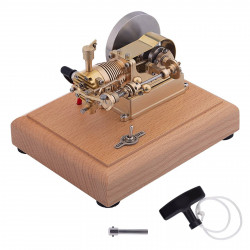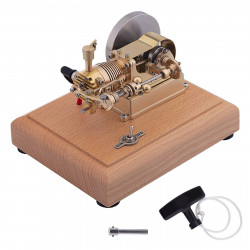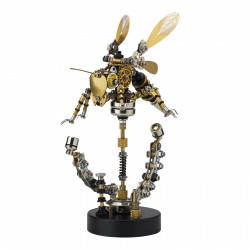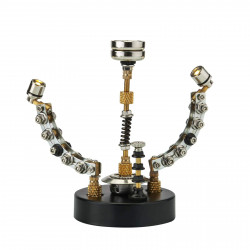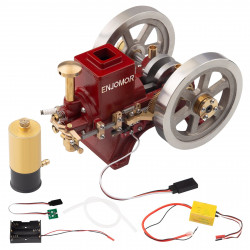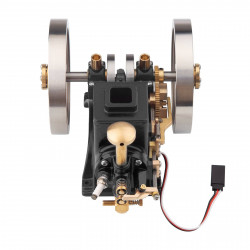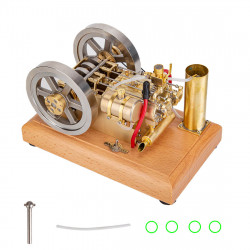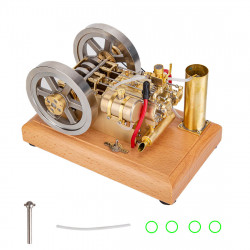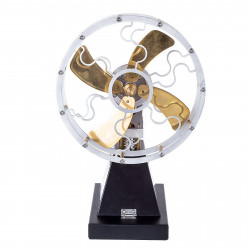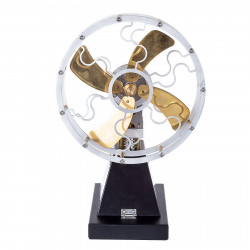5 Of The Best Antique Mini Engine Kits You Can Buy
From classically designed motorcycles like the Janus Halcyon 450 and Kawasaki W800 to the re-release of Atari's 1990 game "Save Mary," retro technology is back in vogue.
The holiday season is approaching. An old engine kit makes a great gift for a teen who likes science. It is also a perfect gift for an adult who enjoys old technology.
V8engineforsale offers a variety of antique engine kits, including steam engine replicas, motorcycle engines, and model boat and airplane engines. They are fully functional and range from old to almost a century old.
None of the kits featured here are meant for small children because they all involve dangerous fuels. These five kits could make a great Christmas gift for an older child who likes cars or learning about engines. They could also be a good gift for an adult who enjoys steampunk style.
MUSA Red Dog model engine
Model boats and airplanes can use the MUSA Red Dog single-cylinder engine kit. This engine kit is versatile and can be used for various purposes. This gasoline-powered, air-cooled engine, which costs $499.99, is modeled by the Kittiwake engine from the 1940s.
Most of the kit's parts are steel, brass, and aluminum alloy. The engine may run on kerosene or gasoline and needs to be lubricated with 5W-20 or 5W-30 4T oil.
The kit requires a pull starting or power drill to start it because it doesn't include a spark plug, base, or ignition system. The engine's single cylinder has a displacement of 7 cubic centimeters, and its power output is roughly.5 PS, or slightly less than 0.5 horsepower.
The only two customers who wrote reviews gave the kit five stars, although they also mentioned that some tweaks were needed to get the engine to function correctly. The engine can run between 1,800 and 6,000 rpm.
Retrol V-twin motorcycle engine
Retrol V-Twin motorcycle engine kit, which retails for $899.99, is a suitable option for motorcycle aficionados. The Harley-Davidson Knucklehead motorcycle engine, which debuted in 1936, is modeled on a 1/5 scale with this kit. This engine kit includes a flat hardwood platform for mounting and is constructed of brass and stainless steel.
The engine is a four-stroke gas engine with an adjustable carburetor. The engine has a total displacement of 4.2 cubic centimeters, with each cylinder measuring 13 millimeters in bore and 16 millimeters in stroke. The engine needs a pre-mixed 25/1 fuel/oil blend for optimal operation and accepts a 1/4-32 Thread ME8 Spark Plug.
Three AA batteries—not included in the kit—provide the spark, and it may be started with a power drill or the pull start cord that comes with it.
The kit received five stars out of five from the two customers who posted reviews. St. Louis resident Mark described it as a "fantastic little machine" and said, "I can't wait to run it—the engine is a functional work of art!" I have a small but expanding collection of these miniature engines, and this one is adorable."
H08 Hoglet
A comparable product to the Retrol V-twin motorcycle engine is the $649.99 H08 Hoglet Engine kit. Another four-stroke V-twin engine in this kit is based on a Harley-Davidson motor from around a century ago.
Similar in size to the last kit, this engine is started by a kick-start lever rather than a drill or pull-start cord. The base is made of wood and measures 150mm x 120mm x 30mm. It is made of brass, stainless steel, and aluminum alloy.
Users must supply engine oil, fuel (95 octane), and the three AA batteries required to create a spark for ignition.
"Engine is well made," commented a five-star reviewer from Bochum, Delaware, Seb. It is simple to set up and operates well. You can't have a very low idle with small V2 engines because there isn't enough weight at the crankshaft/flywheel.
A customer from Tosu, Japan, named AKR46, gave the kit four stars. They recommended that potential buyers ensure they use enough oil in the engine's moving parts for smooth operation. When the engine was having trouble starting, I cleaned the carburetor's interior, and it soon started."
R18 flywheel engine
Consider the $459.99 R18 one-cylinder flywheel engine kit for the automobile historian in your life. The three-wheeled Benz Patent Moterwagen I, which debuted on public roads in 1886, is the model of this engine.
This kit requires three AA batteries (not included) and 95-octane gasoline to operate. It is constructed of brass. The 10-centimeter flywheel can be manually spun to start the engine using a pull rope or a rubber wheel fastened to a power drill.
Günter Krusek had air leaks but fixed them with bigger O-rings and sealant. All four reviewers gave his engine kit five stars.
This kit is a detailed replica of the Carl Benz engine. It has been praised by Henry Bangsberg from Chicago and Harold from Berlin, Delaware. They appreciate its historical significance and beauty. An exquisite piece for collectors."
H75 Tractor Engine
At $1,499.99, the H75 12cc Tractor engine kit is among the most intricate and costly vintage engine kits available on Engine DIY's website. The engine has a bamboo base measuring 250 x 120 x 30 millimeters constructed out of brass and stainless steel.
The ignition system requires three AA batteries, not included, and the engine runs on 95-octane gasoline. The engine may be started manually or with a power drill. The engine's speed can be adjusted using the throttle lever on the motor's side.
Some customers complained about fluids escaping from or into the engine despite the kit's expensive cost. Czech writer Lucas Bilovsky from Brno commented, "The engine's mechanical design is very nice." The motor performs admirably right out of the box. But there's an issue with oil seeping out of the crankcase."
Another fluid leak issue was reported by Andre Häfeli, who did not disclose his location. He wrote, "It's a cool engine, but I had a problem with the cylinder leaking water into the engine."
